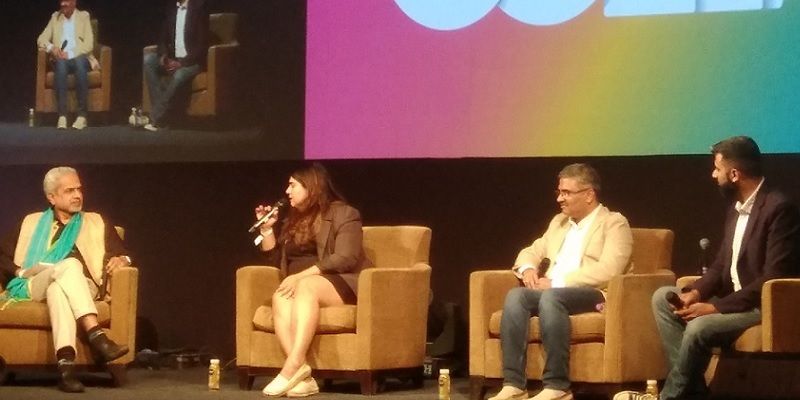How designers and entrepreneurs can collaborate to create value: 15 tips from Pune Design Festival 2019
In our first article on the Pune Design Festival, we discuss success factors, challenges, and examples of collaboration between designers and startup founders.

The 13th annual Pune Design Festival (PDF) wrapped up with the theme of trans-disciplinary collaborations between designers, entrepreneurs, crafts communities, industry, academia, and government.
Organised by the Association of Designers of India (ADI), the two-day event drew 40 speakers and 650 attendees and included workshops, awards, animation films, design expo, mentoring sessions, and even a music performance by the Vasu Dixit Collective. Held at Hyatt Regency, PDF 2019 addressed design education, global partnerships, social innovation, digital design, and narrative impacts.
“Design is niche, yet it is increasingly seen as a game changer. Design education, design-led creative manufacturing, and design-led startups are the top three opportunities for designers in India,” said Ashish Deshpande, ADI President and Co-founder of Elephant Design, in a chat with YourStory.
See also YourStory’s coverage of other design conferences like Singapore Design Week, Design4India, Bengaluru ByDesign, DesignUp, UX India, Design4Success, Design Talks, and BeFantastic. Check out our d-Zen (‘design Zen’) section for in-depth book reviews, interviews, and expert pieces as well.
In this article, we share insights on entrepreneurship from keynotes and panels featuring Vishwas Mahajan (TiE Pune), Shashank Deshpande (Globant), Preeta Sukhtankar (The Label Life), Rohan Rehani (Moonshine Meadery), Pankaj Jhunja (Tata Motors) and Santosh Desai (Future Brands).
1. No field is off-limits for an entrepreneur
Some of the successful entrepreneurs showed how they were able to enter fields where they had no prior experience or formal education. The founders of Moonshine Meadery were not from the beverage industry when they launched their label for mead in India (an alcoholic beverage made from honey), but learnt its business and design from industry professionals.
2. Entrepreneurship is about ideas with execution
It is important to have good ideation not just at the start of the entrepreneurship journey but throughout the ups and downs of the struggle. Creativity and design help in multiple scenarios and settings. Though ideas may be plentiful, they may not always be effective. However, it is key to go beyond ideas to actual on-the-ground execution, design viable products, and engage with real customers. It is important to share ideas (and not cling on to them), as well as build on them.
3. Set trends, don’t just follow trends
Successful entrepreneurs do keep up with market and design trends to follow changing customer habits, but they also set trends by staying ahead of customer needs and aspirations. For example, The Label Life uses stylists to design new kinds of contemporary Western wear for Indian women.
4. Design is an effective bridge
Design can help entrepreneurs with connections across disciplines (as in digital UI) and even different eras (as in contemporary crafts). It helps create meaning for diverse audiences through effective bridges and can leap over boundaries of existing frames to connect the periphery to the core.
5. The design opportunity in the startup ecosystem
In an increasingly digital and converged world, the user interface and cross-channel experience need to be intuitive as well as compelling. Product and service designers can tap this market by offering workshops, seminars, tools and consulting services to mainstream design in the industry; some such consultancies have been acquired by larger tech firms as well.
6. Become founders or co-founders
Designers can engage even more fully in the startup ecosystem by becoming founders, co-founders or chief design officers in these emerging companies, ranging from crafts to e-commerce. Many of the panellists shared how helpful it was to have a co-founder in the ups and downs of the startup journey. This is particularly effective if the co-founders have complimentary skillsets, for example, technology and design. A number of successful 'designpreneurs' and 'artrepreneurs' have already made their mark in this regard.
7. Balance confrontation and consensus
A healthy debate between the diverse co-founders or business heads helps in the early stages of decision-making. Criticism should be taken professionally, and not personally. All points of view should be aired and heard empathetically. But once consensus is reached, all arguments should be closed.

8. The second marriage: investors
The first marriage in a startup is between co-founders; the second is between the founding team and the investors. Investors who are former entrepreneurs are the best fit; they have a better sense of empathy with the struggle of the new founders, having been through the journey themselves.
9. Analogies and metaphors
Sometimes, it helps to use metaphors and analogies to explain how the startup’s offerings fit into the current marketplace scenario. This can help with branding and design of the customer experience. Common examples include becoming the “Uber of X” or the “Netflix of Y.”
10. Ask and you shall receive
The Indian startup ecosystem is maturing, thanks to the rise of entrepreneurship networks like TiE (The Indus Entrepreneurs), academic and government incubators, corporate accelerators, angel investor networks, design associations, and mentorship support networks. Asking specific and structured questions to these experts can provide founders with effective frameworks, case studies and industry connections.
11. Learn how to take advice
There is no shortage of advice for founders on everything from data and design to hardware and hiring. Some of the best advice can actually come from peers or fellow entrepreneurs. It helps to take a lot of advice, but also balance the inputs and take the final decision based on your own gut or instinct. With more experience, founders can learn the art and science of taking advice.
12. Focus on sustainability
The pressure is on the next wave of companies to be not just innovative but also sustainable, to not just perform well in the market but do good for the environment. Sectors like fashion are regarded as among the top polluters after the oil industry, and designers must take every effort to include sustainable practices such as recycling materials and reducing the use of water and disposable plastic.
13. Choosing partners
Strategic partnerships are key for entrepreneurs at scale stage. The choice of partners should be a good fit with the brand voice of the startup. These can include artists and indie musicians for beverage brands, for example. Challenges can include the arrogance of some bigger players, and reluctance to pay on time (if at all). “Don’t do business with assholes,” joked one panellist.
14. Alignment with partners
Corporates can successfully engage with startups for effective partnerships (see my framework of 15 Innovation Tips, which includes accelerators, hackathons, investment, and competitions). However, the “clock speeds” and expectations of enterprises and startups can differ significantly. This calls for large firms to simplify their legal documents such as NDAs to make them jargon-free and easier for startups to engage with them.
15. Design for social innovation
Some of the most pressing problems in India lie in the social sector, due to lack of education, healthcare, access to water, livelihood, human rights, and cultural preservation. Good examples of inclusive design interventions in this sector were presented by Commitment to Kashmir, Anandwan, Good Earth, Foley Designs, and the Partnership for Maternal, Newborn, and Child Health (to be covered in Part II and Part III of our article series).
“At PDF, one consistent message we carry across to the young generation of designers is to look beyond juicy career options. Look at opportunities that India as a country provides. Look at the underserved and overlooked areas and see if that can be your calling,” added ADI’s Ashish Deshpande.
“Designers need to plug in with investment, innovation and entrepreneurship bodies. It is important to collaborate with and support bodies like ADI that engage with the startup ecosystem. Design cannot do this alone, nor can startups benefit by only collaborating with investors or technocrats,” he summed up.
PDF also featured the third annual Design Expo, with product firms, design entrepreneurs, and educational institutes as exhibitors. Many design institutes now hold hackathons and design competitions, and have their own incubators as well for design-led startups.
In sum, ‘trapeze’ can be a good metaphor for collaboration, according to the PDF team. Trapeze symbolises the importance of trust, timing, partnership, inclusion, co-creation, risk-taking, and creativity between entrepreneurs and designers.








![[Funding alert] IIT Kanpur-backed startup Phool.co raises $1.4M in a pre-Series A round](https://images.yourstory.com/cs/2/e641e900925711e9926177f451727da9/Image64ln-1598521641321.jpg)
![[Funding alert] Foodtech startup GO DESi raises Rs 4.5 Cr from Rukam Capital](https://images.yourstory.com/cs/2/79900dd0d91311e8a16045a90309d734/VinayKothari-1582199891458.jpg)


